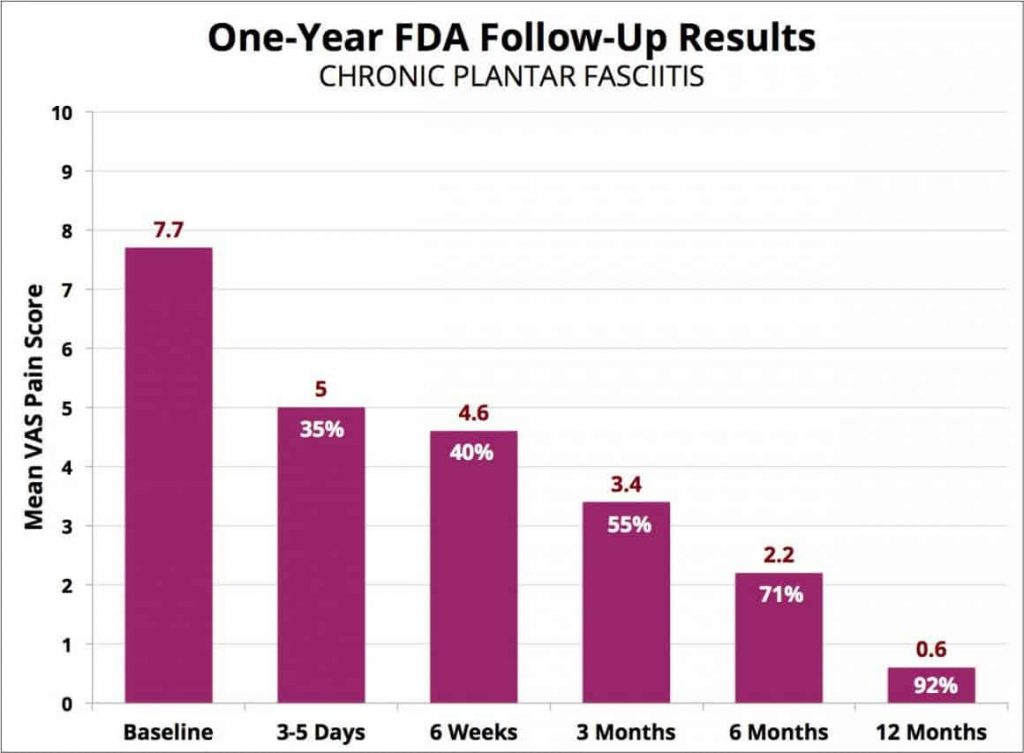Plantar fasciitis is a common condition characterized by painful heels that can take the pep out of your step. This painful condition can keep you from fully enjoying your life. Fortunately, there are ways to help including extracorporeal shockwave therapy (ESWT) at Pro Fusion Rehab Physiotherapy clinics in both Pickering and Milton, Ontario.
What is Plantar Fasciitis?
This malady usually presents itself in adults ages 40 to 60. The condition may be bilateral, meaning it occurs in both feet, or may just be in one. Plantar fasciitis is hallmarked by a stabbing pain in the bottom of your foot resulting in sore heels. If your painful feet issues occur in other areas like the front, side, top, or back of your foot, it may instead be Achilles tendonitis a condition often confused with plantar fasciitis.
What are the Symptoms?
- Heel pain, especially during your first few steps of the day
- Sore heels after long periods of standing
- Painful feet when climbing stairs or standing on your toes
- Pain that gets better with a few steps, but then gets progressively worse through the day
What Causes Plantar Fasciitis?
The ligament that connects your heel bone to your toes is called the plantar fascia. Normally the plantar fascia acts by absorbing the shock felt when stepping on your foot. Repetitive stretching, straining and tearing eventually lead to inflammation and sore heels or plantar fasciitis. While most often seen in middle-aged adults, younger adults like athletes or soldiers can also develop the condition. Sometimes you can develop Plantar Fasciitis without the cause being clear.
What Risk Factors Lead to Plantar Fasciitis?
- Excessive pronation, meaning your feet roll inward too much while walkingIf you have higher arches or flat feet
- Walking, standing, or running for extended periods of time
- Being overweight
- Not wearing proper footwear
- Age
Treatment Options
Plantar fasciitis can be treated in multiple ways. Your physician may at first recommend resting and icing the area. Nonsteroidal Anti-Inflammatory Drugs (NSAIDS) including ibuprofen can also be taken. Patients may experience some temporary relief from their symptoms by wearing special footwear or devices made specifically for those suffering from flat feet, heel spurs, or other causes of foot pain. Sometimes steroids can be locally injected. In cases where these treatments are not enough to help there are also physiotherapy, electrotherapy, or in extreme cases a person may require surgical intervention.
What is Shock Wave Therapy?
Extracorporeal shockwave therapy, or ESWT, is a noninvasive, nonsurgical therapeutic technique that involves the use of pulsed sound waves to treat plantar fasciitis. It can also treat other issues like Achilles tendonitis, heel spurs, or tennis elbow. This physiotherapy is very different from radial shockwave therapy. Radial therapy tends to work better with superficial injuries. True shock waves are short and intense as opposed to the ones created by radial shockwave therapy, meaning it is not truly delivering shock waves at all.
There are more information about Shockwave Therapy on our website:
Frequently Asked Questions on Shock Wave Therapy
1. How does shockwave therapy work, to help plantar fasciitis?

The shock waves introduce a small amount of controlled stress to the plantar fascia, which then restarts the body’s natural healing process. Patients have reported a significant reduction in heel pain and symptoms, as well as an increase in the ability to engage in activities that previously brought on symptoms.
Medical researches and publications:
Extracorporeal shock wave therapy for plantar fasciitis: randomised controlled multicentre trial
2. How long does the treatment take?
During the approximately 5 to 10 long minute treatment, shockwaves are delivered through a device that is positioned over the bottom of the foot, allowing energy to be sent directly to the affected area.
3. How many sessions do I need?
Many Pro Fusion Rehab clients report the alleviation in plantar fasciitis symptoms, including painful heels after just one treatment. It takes between 8 and 10 weeks to see an improvement in the condition, with maximum improvement seen around 12 weeks post treatment. Since every person is different the best way to know how many treatments will be necessary is to receive a consultation.
4. Is shockwave therapy treatment painful?
Most clients report that the treatment is only mildly uncomfortable, rather than painful. The most common patient complaint during therapy is mild pain or discomfort during and immediately following the procedure.
5. Is shockwave therapy safe?
Yes! There have been a tremendous number of clinical study experiments conducted that have confirmed both the effectiveness and safety of extracorporeal shockwave therapy for plantar fasciitis. The treatment is FDA and Health Canada approved, with clinical studies globally.
6. Who should not have shockwave therapy?
This form of shockwave therapy is not recommended for clients that have pacemakers as the therapy could interfere. Patients that are currently taking prescription medications which interfere with the body’s blood clotting process such as coumadin or warfarin are not advised to have shockwave therapy. Pregnant women and children are not candidates for the treatment. Individuals suffering from acute episodes rather than chronic plantar fasciitis are also precluded from treatment.
Pro Fusion Rehab Can Help
Our highly-trained team aims to restore your pain-free life so that you can enjoy your life again. Please contact us to schedule a consultation at our state of the art physiotherapy clinic with locations in Pickering and Milton.
